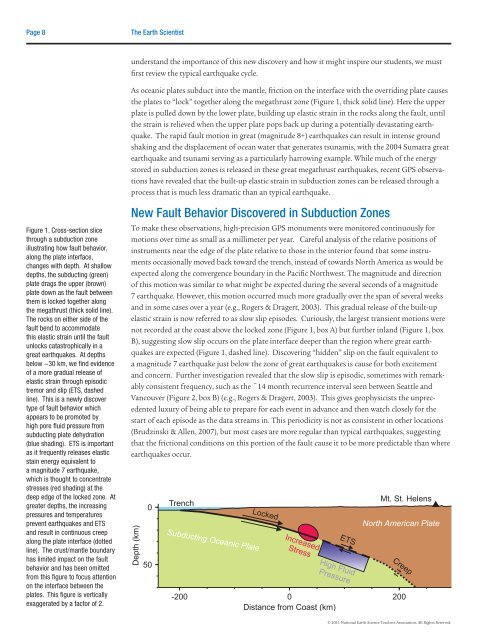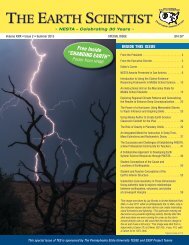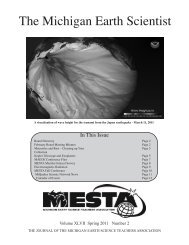The Earth Scientist
The earTh ScienTiST - NESTA
The earTh ScienTiST - NESTA
You also want an ePaper? Increase the reach of your titles
YUMPU automatically turns print PDFs into web optimized ePapers that Google loves.
Page 8<br />
<strong>The</strong> <strong>Earth</strong> <strong>Scientist</strong><br />
understand the importance of this new discovery and how it might inspire our students, we must<br />
first review the typical earthquake cycle.<br />
As oceanic plates subduct into the mantle, friction on the interface with the overriding plate causes<br />
the plates to “lock” together along the megathrust zone (Figure 1, thick solid line). Here the upper<br />
plate is pulled down by the lower plate, building up elastic strain in the rocks along the fault, until<br />
the strain is relieved when the upper plate pops back up during a potentially devastating earthquake.<br />
<strong>The</strong> rapid fault motion in great (magnitude 8+) earthquakes can result in intense ground<br />
shaking and the displacement of ocean water that generates tsunamis, with the 2004 Sumatra great<br />
earthquake and tsunami serving as a particularly harrowing example. While much of the energy<br />
stored in subduction zones is released in these great megathrust earthquakes, recent GPS observations<br />
have revealed that the built-up elastic strain in subduction zones can be released through a<br />
process that is much less dramatic than an typical earthquake.<br />
Figure 1. Cross-section slice<br />
through a subduction zone<br />
illustrating how fault behavior,<br />
along the plate interface,<br />
changes with depth. At shallow<br />
depths, the subducting (green)<br />
plate drags the upper (brown)<br />
plate down as the fault between<br />
them is locked together along<br />
the megathrust (thick solid line).<br />
<strong>The</strong> rocks on either side of the<br />
fault bend to accommodate<br />
this elastic strain until the fault<br />
unlocks catastrophically in a<br />
great earthquakes. At depths<br />
below ~30 km, we find evidence<br />
of a more gradual release of<br />
elastic strain through episodic<br />
tremor and slip (ETS, dashed<br />
line). This is a newly discover<br />
type of fault behavior which<br />
appears to be promoted by<br />
high pore fluid pressure from<br />
subducting plate dehydration<br />
(blue shading). ETS is important<br />
as it frequently releases elastic<br />
stain energy equivalent to<br />
a magnitude 7 earthquake,<br />
which is thought to concentrate<br />
stresses (red shading) at the<br />
deep edge of the locked zone. At<br />
greater depths, the increasing<br />
pressures and temperatures<br />
prevent earthquakes and ETS<br />
and result in continuous creep<br />
along the plate interface (dotted<br />
line). <strong>The</strong> crust/mantle boundary<br />
has limited impact on the fault<br />
behavior and has been omitted<br />
from this figure to focus attention<br />
on the interface between the<br />
plates. This figure is vertically<br />
exaggerated by a factor of 2.<br />
New Fault Behavior Discovered in Subduction Zones<br />
To make these observations, high-precision GPS monuments were monitored continuously for<br />
motions over time as small as a millimeter per year. Careful analysis of the relative positions of<br />
instruments near the edge of the plate relative to those in the interior found that some instruments<br />
occasionally moved back toward the trench, instead of towards North America as would be<br />
expected along the convergence boundary in the Pacific Northwest. <strong>The</strong> magnitude and direction<br />
of this motion was similar to what might be expected during the several seconds of a magnitude<br />
7 earthquake. However, this motion occurred much more gradually over the span of several weeks<br />
and in some cases over a year (e.g., Rogers & Dragert, 2003). This gradual release of the built-up<br />
elastic strain is now referred to as slow slip episodes. Curiously, the largest transient motions were<br />
not recorded at the coast above the locked zone (Figure 1, box A) but further inland (Figure 1, box<br />
B), suggesting slow slip occurs on the plate interface deeper than the region where great earthquakes<br />
are expected (Figure 1, dashed line). Discovering “hidden” slip on the fault equivalent to<br />
a magnitude 7 earthquake just below the zone of great earthquakes is cause for both excitement<br />
and concern. Further investigation revealed that the slow slip is episodic, sometimes with remarkably<br />
consistent frequency, such as the ~14 month recurrence interval seen between Seattle and<br />
Vancouver (Figure 2, box B) (e.g., Rogers & Dragert, 2003). This gives geophysicists the unprecedented<br />
luxury of being able to prepare for each event in advance and then watch closely for the<br />
start of each episode as the data streams in. This periodicity is not as consistent in other locations<br />
(Brudzinski & Allen, 2007), but most cases are more regular than typical earthquakes, suggesting<br />
that the frictional conditions on this portion of the fault cause it to be more predictable than where<br />
earthquakes occur.<br />
Depth (km)<br />
0<br />
50<br />
Trench<br />
Subducting Oceanic Plate<br />
Locked<br />
Increased<br />
Stress<br />
ETS<br />
High Fluid<br />
Pressure<br />
North American Plate<br />
Creep<br />
-200 0 200<br />
Distance from Coast (km)<br />
Mt. St. Helens<br />
© 2011 National <strong>Earth</strong> Science Teachers Association. All Rights Reserved.






